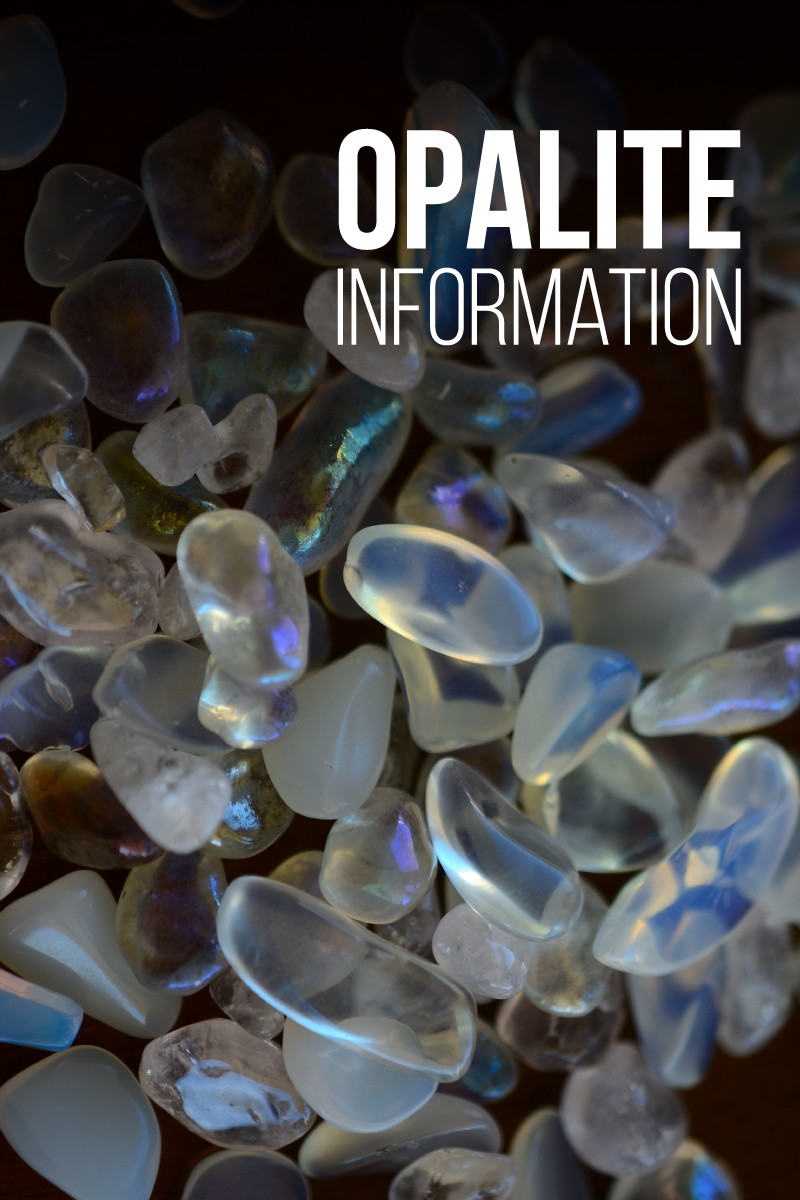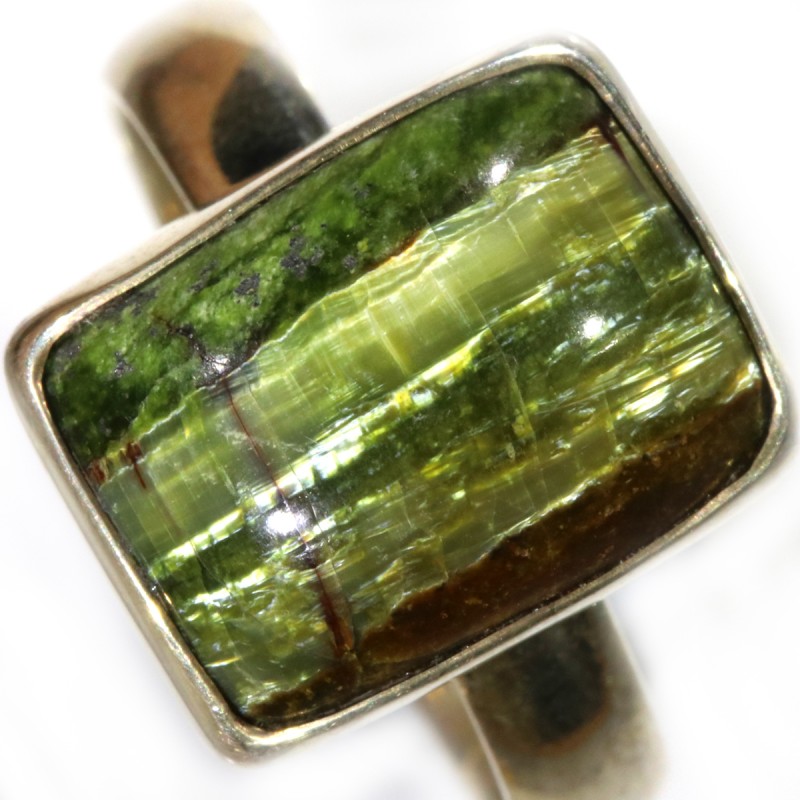
オパライト:歴史、象徴性、意味など
 オパールに関する読み物が好きな方なら、「オパライト」という言葉を偶然見かけて、「オパライトとオパールの違いは何だろう?」と疑問に思ったことがあるかもしれません。
オパールに関する読み物が好きな方なら、「オパライト」という言葉を偶然見かけて、「オパライトとオパールの違いは何だろう?」と疑問に思ったことがあるかもしれません。
オパールは母なる大地によって作られますが、人工オパライトはガラス樹脂の一種で、オパールの模造品として用いられることからその名が付けられました。プレシャスオパールと混同しないようご注意ください。どちらのタイプのオパライトも、高級オパールの手頃な価格の代替品としてご利用いただけます。
オパライトは天然に採掘できますか?はい、可能ですが、プレシャスオパールとは異なる石です。プレシャスオパール特有のファイアーや遊色効果は見られません。しかし、オパライトをまだ諦めないでください。手頃な価格と美しさの両方を兼ね備えた宝石だからです。
オパライトとは、人工オパールだけでなく、一般的なオパールの一種も指します。天然オパライトは人工ではなく、内包物が多く、しばしばシャトヤンシー(キャッツアイ効果とも呼ばれる)が見られる、自然発生的な緑または紫色のオパールです。
さらに詳しく知りたいですか?さあ、始めましょう!
オパライトとは何ですか?
合成オパライトと天然オパライトについて少し混乱があるので、ここで明確にしておきましょう。人工オパライトは、半透明から乳白色の石で、通常は乳白色のガラスで作られていますが、プラスチックや樹脂で作られることもあります。ガラスオパライト、アルゴノン、シーオパールとも呼ばれます。業界では、「人工」ではなく「合成」「模造」「イミテーション」という用語が使われることがあります。
このガイドでは、「合成オパライト」は人工オパライトを指します。「合成オパール」は化学組成が異なる石を指します。
合成オパライトは一見、無色または白色に見えます。暗い背景に置けば、淡い青色が浮かび上がります。明るい背景に置けば、白い地色にほのかな桃色の輝きが浮かび上がります。
天然オパライトは一般的なオパールの一種であるため、シリカと水という同じ組成を持っています。含水シリカは小さな球状構造をしており、天然オパライトにキャッツアイ構造がある場合、含水シリカ球はピラミッド状に積み重なっています。

オパライト vs. ムーンストーン
ムーンストーンは、カリウム、アルミニウム、シリカからなる長石鉱物です。非晶質のオパールやオパライトとは異なり、ムーンストーンは単斜晶系結晶構造を形成します。
ムーンストーンはオパライトに似ているため、オパライトは「オパール ムーンストーン」として販売されることがよくあります。
オパライトとムーンストーンをどうやって見分けますか?
まず第一に、人工オパライトはムーンストーンとは異なり、ムーンストーンは天然に形成されるという点が異なります。両者は似たようなスカイブルーの色合いときらめく光沢を持ちますが、ムーンストーンの内部には曇った内包物があり、オパライトの乳白色の内部にはそのような内包物は見られません。
天然のオパライトは、色、硬度、そして宝石の系統においてムーンストーンとは異なります。オパライトの硬度はモース硬度計で5~6.5で、ムーンストーンの6~6.5よりわずかに低い値です。オパライトの組成はオパライトファミリーに属し、ムーンストーンは長石に属します。
人工および天然のオパライトの特性を詳しく見ていきましょう。

オパライトの仕様
色: 合成 - 無色から白、青または桃色の色合い、天然 - 緑、ライラック、または紫、灰色、黒、または青みがかった黒の含有物
結晶構造:両方 - 非晶質
硬度: 合成 - 5; 天然 - 5~6.5
光沢: 合成 - ガラス質、天然 - ガラス質下から蝋状
透明性: 合成 - 半透明から透明; 天然 - 半透明から不透明
屈折率:合成 - 1.50~1.52、天然 - 1.43~1.52
密度: 合成 - 2.6; 天然 - 1.9-2.3
胸の谷間: 両方 - なし
破片:合成 - 貝殻状、天然 - 貝殻状~不均一
シャトヤンシー:天然オパライトの一部に存在
オパライトに関する科学は比較的最近のものであり、この石の歴史において重要な役割を果たしています。
オパライトの歴史
天然オパライトの歴史は、オパールの歴史の始まり、つまり数百万年前から始まります。オパライトの形成は、私たちが知る限り約2000万年前に始まりました。最古のオパール工芸品はケニアで発見され、紀元前4000年頃のものとされています。
「オパライト」という用語が文献に初めて登場したのは1945年のことです。宝石学者や地質学者向けの用語集では、「オパライト」はコモンオパールの同義語として定義されています。ちなみに、コモンオパールとは遊色効果を示さないオパールのことです。
1972年、フランスの化学者ピエール・ギルソンは、世界初の合成オパールの開発に成功し、オパールの歴史に名を残しました。2年後には、この合成オパールを販売しました。ギルソンは、オーストラリアの科学者P.J.ダラーとJ.V.サンダースが1960年代に行ったオパールの内部構造に関する研究に着目しました。
ギルソンが最初に合成オパールを販売したとき、彼はそれを「ギルソン合成オパール」と名付けました。1980年、ギルソンは自身のデザインと一部の設備を日本の企業に売却し、同社も合成オパールの製造を開始しました。合成オパールの市場が拡大するにつれ、「オパライト」は合成オパールの新しい呼び名となりました。
ギルソンの合成オパールは人工オパライトではないことに注意が必要です。ギルソンの石はシリカでできており、合成オパライトはガラスまたはプラスチック素材でできています。しかし、ギルソンの革新は合成オパライトの人気が高まる道を開きました。
今日、合成オパライトは装飾品やヒーリング用のタンブルストーンとしてよく使用されています。ところで、オパライトのヒーリング効果とは何でしょうか?
オパライトの象徴性と治癒力
オパライトの治癒特性を理解するには、まずオパライトが何を意味するのかを知る必要があります。
一般的に、オパライトは明晰さ、新たなスタート、そして静けさを象徴します。合成オパライトの涼しげなブルーの色合いは、澄み切った空を彷彿とさせ、楽観主義と将来への見通しを象徴しています。
オパライトは、水のエレメントに属する星座、蟹座、蠍座、魚座を表しています。心を落ち着かせ、気分を高めるといった精神的な効能を持つオパライトは、特別なリラクゼーションを必要とする繊細な水の星座に最適です。
10月に生まれた蠍座の人は、 10月の誕生石であるオパールのより手頃な代替品としてオパライトが役立つため、二重の利益を得ることができます。

オパライト石は身体の治癒にどのような効果がありますか?
身体的には、オパライトは循環器系と呼吸器系のバランスを整えるのに役立ちます。また、不眠症や悪夢に悩む人にも効果があると言われています。
感情的な癒しにおいて、オパライトは悲しみや悲しみを和らげ、不安な思考を鎮める効果があることが知られています。多くのエネルギーヒーラーは、自尊心を高め、他者とのつながりを強めるためにオパライトの使用を推奨しています。
一部のスピリチュアル実践者は、オパライトを有名な魔術師にちなんで「メラナイト」と呼ぶことがあります。これは、この石が神秘的なコミュニケーションへの扉を開くという評判に由来しています。オパライトは直感力を高め、霊界からのビジョンやメッセージに心を開き、叡智を与えてくれると言われています。
オパライトはどのチャクラに良いのでしょうか?
オパライト チャクラ ヒーリングは、第三の目チャクラに最適です。第三の目チャクラでは、宇宙とその中の自分の位置についてより深い理解が得られます。
第三の目チャクラがブロックされていると、自己主張ができず、落ち着きがなくなることがあります。オパライトを使ってチャクラを開くと、より深い洞察力と受容力を感じることができるでしょう。
オパライトの価値について詳しく知りたいですか?詳しくご説明いたします!
オパライトの品質要因
オパライトのジュエリーや石を選ぶ際には、その宝石の価値に何が影響しているかを知っておくと、安心して購入することができます。合成オパライトと天然オパライトの価値は、色、透明度、カットなど、いくつかの要素によって決まります。
色
天然オパライト:石の原色は、通常、苔のような緑、ラベンダー、または紫です。濃い色の内包物は、黒、灰色、または青みがかった黒で、脈状または樹枝状の模様として現れることがあります。
合成オパライト:前述の通り、合成オパライトは背景によって色が変わります。白い背景ではライトブルーですが、暗い背景ではピーチピンクやオレンジ色になります。
明瞭さ
天然オパライト:天然オパライトは内包物が多いため、他の宝石ほどクラリティのグレードはオパライトの価値に重要ではありません。ただし、半透明の標本は不透明の標本よりも若干高い価格で取引されることがあります。
合成オパライト:ほとんどの合成オパライトは内部に欠陥がなく、非常に透明度が高いです。欠陥がある場合、通常はガラスオパライトに気泡として現れ、石の価値を下げます。
カット
天然オパライト:天然オパライトは、楕円形や長方形など、様々なカボションカットが施されることが多いです。タンブルカットのオパライトは一般的で、原石のオパライトスラブも一般的です。オパライトのカボションカットは、ジュエリーセッティングにも使用されます。キャッツアイオパライトは、指輪によく使用されます。
合成オパライト: これらの石はほとんどの場合、カボションまたはビーズとしてタンブル加工またはカットされています。
カットされる前に、オパライトはどのように作られるのでしょうか?

オパライトの形成と産地
人工オパライトのほとんどはガラスで作られています。ガラスは、天然オパールの火山活動を可能な限り再現するために、ドロマイトと金属で作られることが多いです。
他のガラスと同様に、この工程はまず原料を溶かして液体にし、その後、混合物を冷却して固めるところから始まります。ドロマイトは、溶かした材料の粘性を維持し、石を傷からより強く保護するため、オパライトガラスに最適です。
天然のオパライトは他のオパールと同じように形成されます。水は地下の割れ目や裂け目に浸透し、その過程でシリカ球を拾い上げます。水分のほとんどは蒸発し、美しいオパライトが残ります。
シリカ球の大きさと密集度が石の緑色を生み出し、その背後には形成時に存在した鉱物(モスアゲートなど)が暗い内包物として存在しています。石にキャッツアイ効果が見られる場合、シリカ球はピラミッド型をしています。
では、オパライトはどこで見つかるのでしょうか?
オパライトの場所
合成オパライトの主な産地は、オーストラリア、ニュージーランド、トルコ、そして米国のアリゾナ州、ジョージア州、カリフォルニア州です。
天然のオパライトは、以下を含むさまざまな場所で見つかります。
オーストラリア
ブラジル
カナダ
アイスランド
メキシコ
ペルー
スロバキア
タンザニア
アメリカ合衆国
イギリス
天然キャッツアイ・オパライトは主にアフリカ、特にエチオピアとタンザニア産です。エチオピア産キャッツアイ・オパライトはシルバーとピンクの色合いがわずかに異なります。
オパライトの購入をお考えですか?価格面での見通しについてお話ししましょう。

オパライトの価値
まず、天然石としてのオパライトの価値についてご説明します。天然オパライトは、産地によって価格が変動する場合があります。
卸売価格では、ウェロ産オパライト宝石は通常1カラットあたり8~20ドルですが、中には1カラットあたり65ドルに達するものもあります。エチオピア産オパライトはより手頃な価格で、通常は1カラットあたり0.60~1ドルです。もちろん、これらの価格はオパライトがキャッツアイオパライトではないことを前提としています。
キャッツアイ オパライト宝石はエチオピア産オパライトより若干高価ですが、それでも 1 カラットあたり 1 ~ 4 ドルと手頃です。
合成オパライトは通常、カラット数ではなく種類ごとに販売されます。タンブルストーンは通常1ドルから3ドルです。オパライトのネックレスやポイントストーンなど、より職人技が求められるアイテムは、サイズやその他の付属品(チェーン、留め具など)に応じて2ドルから25ドル程度になります。
お金を有効活用し、オパライト石を長持ちさせるには、オパライトの掃除方法を知っておく必要があります。
オパライトのクリーニングとお手入れ
天然オパライトも人工オパライトもお手入れは簡単です。どちらの石も、温かい石鹸水と柔らかいブラシ(歯ブラシなど)を使って、汚れやゴミを優しくこすり落としてください。オパライトはすぐに、あのきらめく虹色の輝きを取り戻します!
ただし、天然オパライトがダブレットまたはトリプレットの場合は、熱湯、オイル、石鹸の使用は避けてください。これらの場合は、柔らかい布で表面を拭くだけにしてください。

石をヒーリングに使う予定ですか?オパライトの浄化方法も知っておく必要があります。
石の浄化には様々な方法がありますが、日光を使うことをお勧めします。石を30分から1時間ほど日光に当てると、オパライトに宿るネガティブなエネルギーが消えていきます。
オパライトは、使用頻度にもよりますが、少なくとも月に1回、あるいはそれ以上の頻度で浄化することをお勧めします。ただし、色褪せを防ぐため、浄化のたびに石の異なる面を太陽に向けてください。
オパライトで光を見よう!
オパライト宝石について知っておくべきことはこれですべてです!天然と人工のオパライトにまつわる科学的根拠と象徴性をすべてご理解いただけたかと思います。それぞれの石がなぜ時代とともに人気を博してきたのか、お分かりいただけるでしょう。オパライトは、一味違うオパールをお探しなら、楽しくお手頃な選択肢です。
したがって、オパールのより手頃な代替品、またはワードローブに加える素朴なボヘミアン風の宝石を探している場合、オパライトは、私たち全員が知っていて愛している、輝くカラフルな乳白色を加えるのに最適です。
オパライトをお買い求めください!
Opal Encyclopedia検索
最新記事
ブラックオパールは、オパールの中でも最も人気のある種類です。深いベースが表面に虹色の輝きを放ちます。ブラックオパールの用途、特性、歴史、そして価値についてご紹介します。
7th Dec 2025
オパールの等級付け方法と価格に影響を与える要因をご紹介します。色や輝き、カットや産地など、それぞれのオパールの価値がどのように評価されるのか、価格帯の例とともにご紹介します。
19th Jul 2023
記事のカテゴリ
All there is to know about Opals including Black Opals, Ethiopian Opals & Boulder Opal
14記事数
Check out our fascinating information and articles on all things amazing in the Opal world
41記事数

